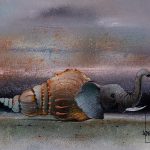Interior/Exterior Visions: Examining the Art of Fanch Ledan
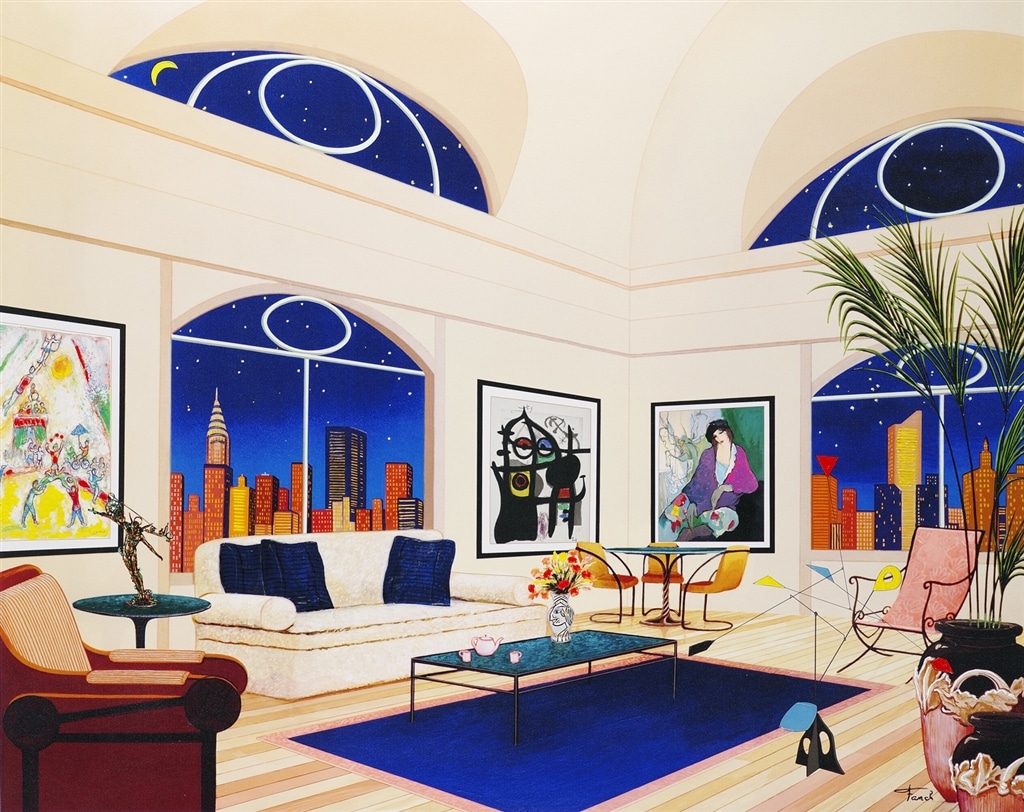
“New York Nights II,” Fanch Ledan
François “Fanch” Ledan is an exceptional painter and printmaker. In following essay—taken from the book “Fanch: The Graphic Work”—art scholar Eleanor Hight, Ph.D. provides an excellent history of Fanch’s career and talks about the origins of the artist’s iconic “interiorscapes.”
A recent original print by Fanch Ledan offers a window onto this artist’s world, a graceful synthesis of observed fact, artistic homage, and reverie. In “Interior with Buddha,” 2001, a serigraph from a painting that was done the previous year, we look down on an elegant room. Though no one is present except for us, the viewers, we can piece together the story of a life. Classical music played on a harp, reading while taking tea, appreciating antiques, and the Spanish masters of modern art—Picasso and Miró.
All is ordered by an underlying geometry—the square columns, the vertical strings of the harp, the pink and rose stripes of the upholstery. The colors, too, contribute to a sense of harmony and quiet. Intense hues of orange, yellow, and blue-green in the furniture and artwork are modulated by the softer complementaries of pinks and blues. While these details tell of a cultivated life in a grand interior, the image shows that the artist is equally concerned with other worlds.
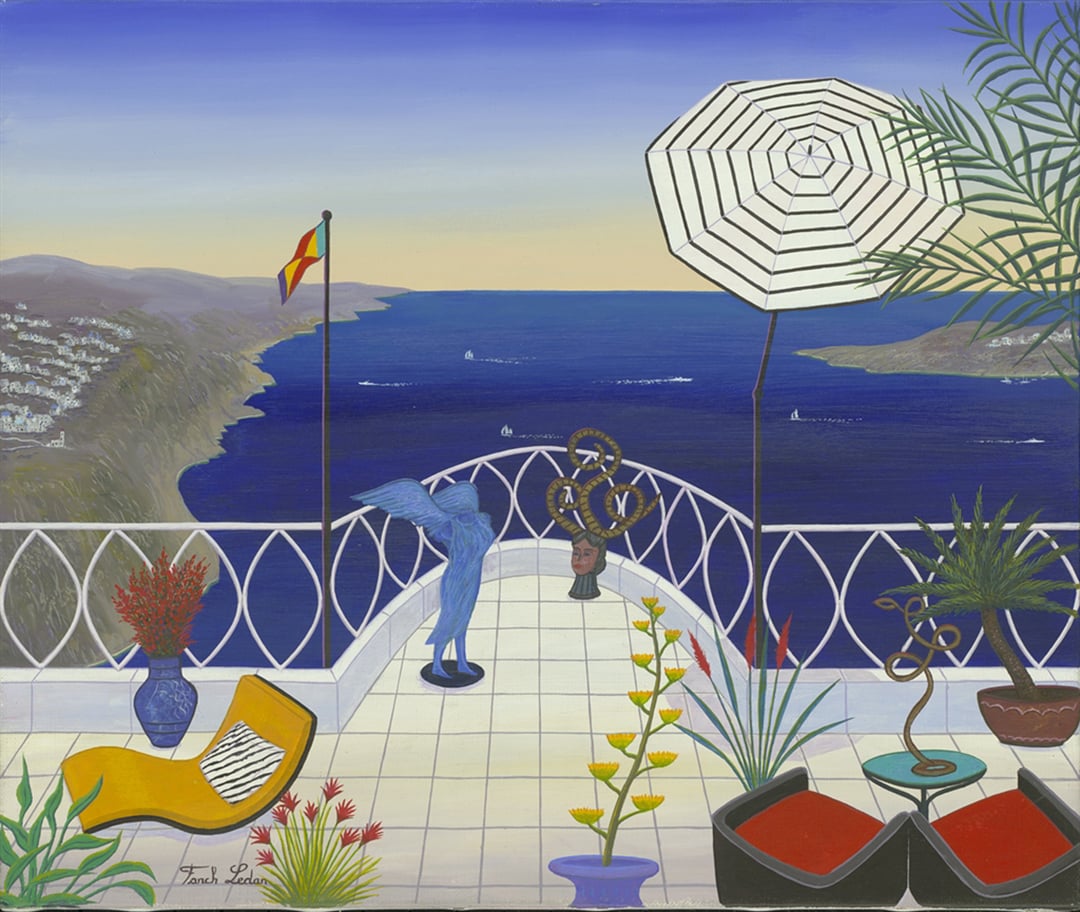
“Above Santorini” (2008), Fanch Ledan
Taking a cue from the glasses left on a chair, we change our field of vision from near to far, either literally out the window to the sparkling cityscape at night or, as implied by the pink quartz Buddha elevated on its pedestal, spiritually to the sky above. A perfect world of comfort and art is juxtaposed with the infinite world of dreaming.
The basic elements of this work—the high vantage point, the absent but implied presence of participants, the order enhanced by color, the distant view—characterize most of Fanch’s mature work, both his paintings and his graphic works. The tremendous appeal of his art comes from the delicate balance, but underlying tension, between what is real and what is possible.
His cheeriness, often exuberance, is balanced by both worldly knowledge and personal introspection. Fanch chooses from his meticulously rendered paintings, a relatively small yearly output of around 25-30 works, those images he will make into original prints. From the beginning of his career, he saw his greatest accomplishment to be the publishing his art so that it might be more broadly known. Over the last three decades, he has created a staggering number of limited editions…
The art created by François Ledan, known today primarily by his nickname Fanch, is inextricably tied to the events of his life. His identity as a Breton, his years studying, living, and working in the United States and France, his wanderlust—all have shaped his world view and thus his art. A closer look at the path he has traveled offers another window onto the world he creates through his paintings and his graphic art.
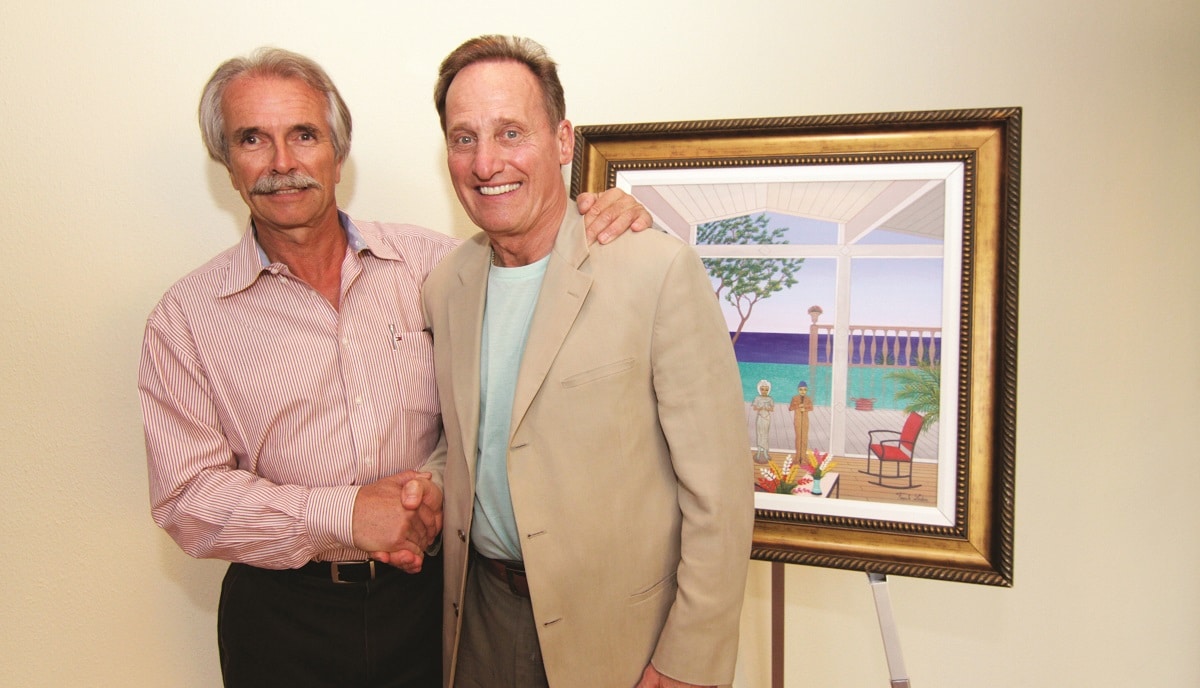
Fanch Ledan and Park West Gallery Founder and CEO Albert Scaglione
Born in 1949 in Pontivy, Brittany, in northwestern France, Fanch was the youngest child of a doctor (his father) and a dentist (his mother). He was educated in local schools before furthering his undergraduate and graduate school studies in Paris. Though talented in mathematics and science, living in Paris drew his attention to the charms of the city and its famed art scene.
By the time he earned his three bachelor’s degrees in mathematics, science, and philosophy at the precocious age of nineteen, he had started to paint his first small paintings—street scenes of Paris. He had also commenced his life of constant travel with an excursion to Greece, Hungary, and Yugoslavia. At first, Fanch followed the professional life chosen by his parents and siblings (his brother is an engineer and his sister an orthopedist).
He studied business in Rennes, Brittany, and in Paris, where he obtained a master’s degree from the École Supérieure des Sciences Commerciales Appliqués in 1972. During this time in Paris, he also met students at the École des Beaux-Arts and visited the major museums and galleries.
Yet Fanch longed to travel to the United States and, luckily, his parents consented on the condition that he continue his studies. Thus, in 1972, he entered the Master of Business Administration program at Sacramento State University, where he obtained his degree the following year.
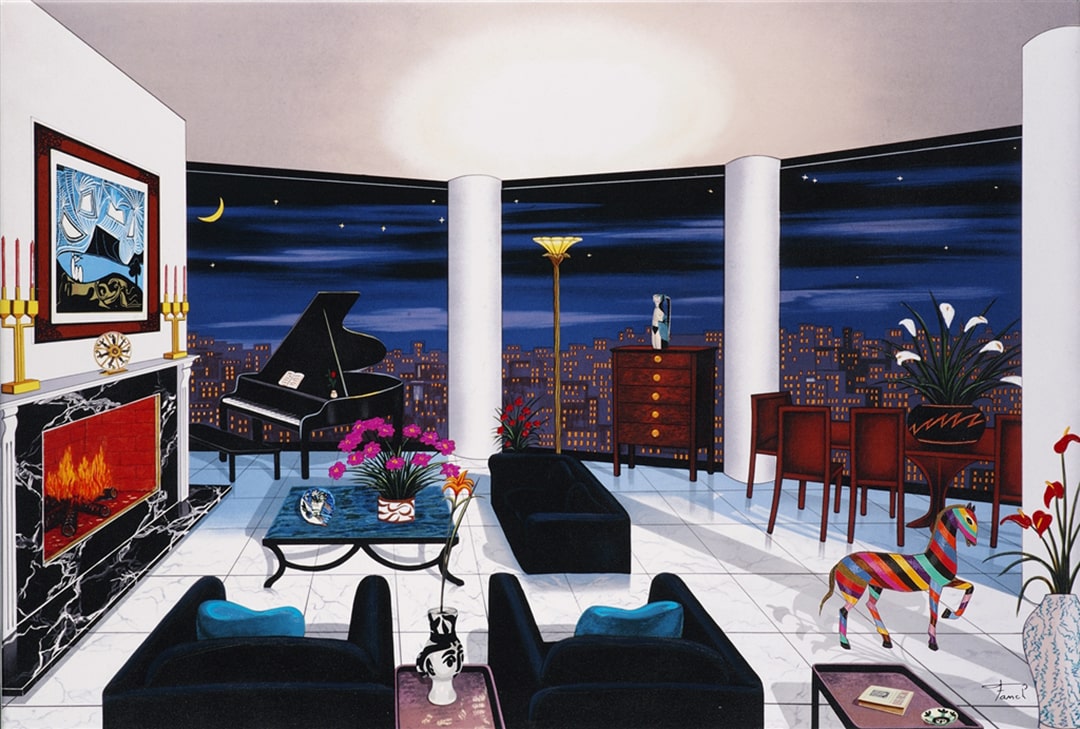
“Interior with Picasso II” (2016), Fanch Ledan
The year 1973 was important, however, for another reason. Fanch decided to show some of his paintings to McInnes Bromfield, director of the Pantechnicon Gallery in San Francisco and, to his surprise, he offered Fanch his first exhibition at the gallery. The next year, this was followed by another show at the Pantechnicon Gallery, as well as exhibitions in Los Angeles, Laguna Beach, New York, and Milan. Suddenly, Fanch realized he could make his living by doing what he loved most and what had only been an avocation up to this point—creating art.
In 1974, Fanch needed to return to France to fulfill his obligation for military service, but what could have been an unwelcome hiatus in a burgeoning career became instead, as it has often seemed in his serendipitous life, a milestone. Fortunate to obtain a military administrative post at the Palace of the Legion of Honor in Paris, Fanch dedicated his time after work to his art, turning once again to Parisian street scenes.
Fanch’s flat, which doubled as his studio, was located on Rue Jolivet in Montparnasse over a lithography shop. Fanch became a regular visitor at Atelier Noël, where he learned zinc plate lithography. In 1975, he also had an exhibition at the atelier of his first forays into printmaking there, along with a selection of his paintings.
Today, Fanch recalls how thrilled he was at the time to “be published,” which he saw then, as now, to be the ultimate achievement for an artist. This two-year sojourn in Paris also included the publication of his first edition of lithographs by Éditions Tallandier. Thus, at the outset of his career, a prominent Parisian publisher admired his art enough to take a financial risk by investing in the production of his original prints.
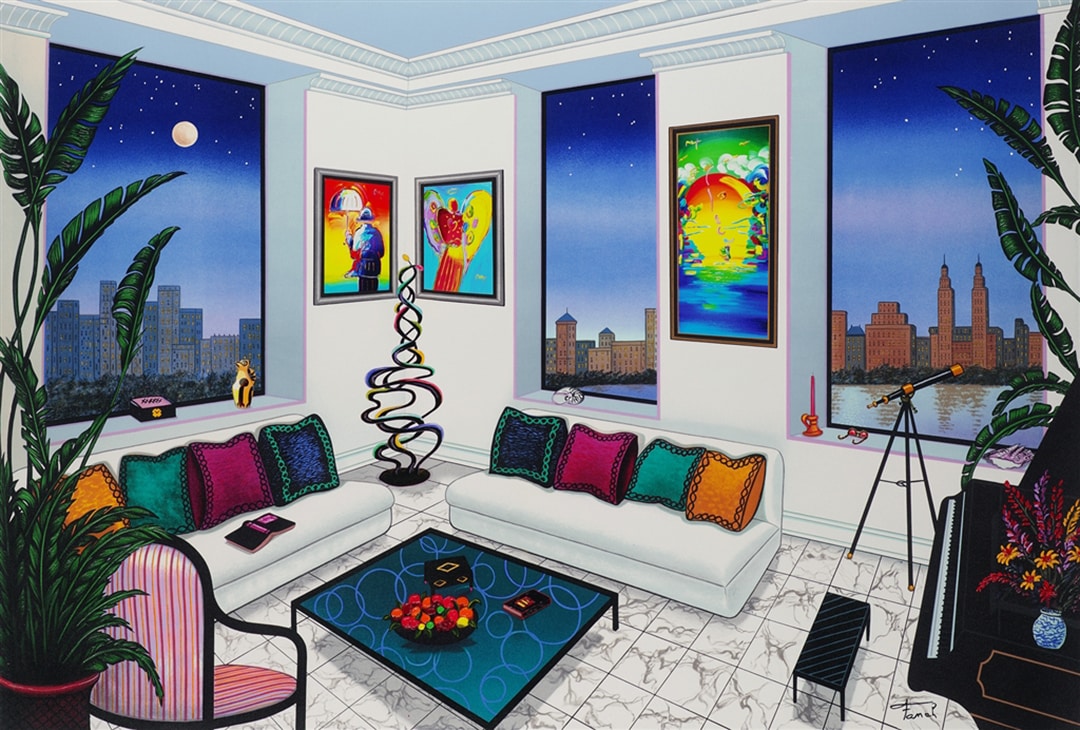
“New York Moonscape II” (2016), Fanch Ledan
After he completed his military service in France, Fanch decided to return in 1975 to San Francisco, the site of his first artistic success. Now a permanent resident of the United States, he purchased a house and studio across the Bay in Sausolito, where he would live and work for the next sixteen years. However, he continued to travel back and forth between California and France, as well as to other areas of the globe.
By the time Fanch settled in California, he was devoted to graphic art, and he worked to hone his skills in a variety of printmaking techniques. He studied serigraphy, or fine art silk-screening, and stone lithography in both San Francisco and Paris, at first printing and sometimes publishing his works himself. Over the next twenty years, he would work in a number of highly-esteemed printing studios in these and other cities around the world, including London, New York, Los Angeles, and Tel Aviv.
The paintings and lithographs from the 1970s and early 1980s display characteristics often associated with “naive” art, and a number of his early exhibitions were held in galleries and museums that specialized in this type of art, such as the Centro d’Arte Naivo in Milan and the Galerie Naïfs et Primitifs in Paris. His views of Paris, a city which had embraced naive art since the early twentieth century, display the attention to minute detail, the use of brightly-colored accents, and the disproportionate and simply rendered figures typical of a self-taught artist.
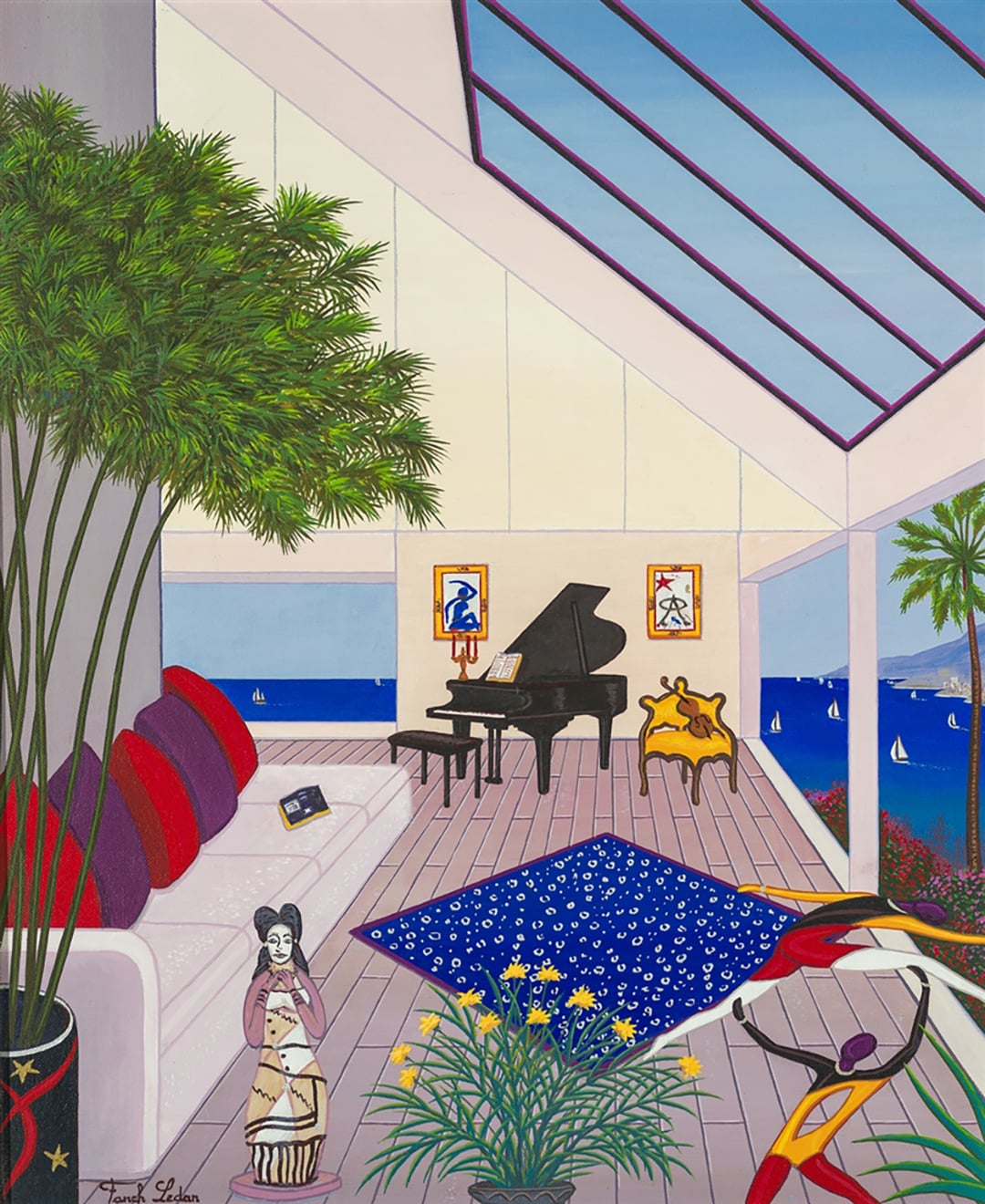
“Interior with Velux” (2005), Fanch Ledan
Fanch’s early naive style can be seen in his painting “Chez l’Artiste” (Home of the Artist, 1979), a view of his own neighborhood in Montparnasse. In addition, Fanch’s images of the streets, parks, and bridges of Paris, as well as leisure activities—skating, riding in carriages, enjoying music in the park—are reminiscent of the subjects depicted by the French Impressionists. He portrayed similar subjects in this style for scenes in the United States, as in his painting from 1979 entitled “South Street New York” (lithograph, 1980). Paintings such as this of New York City or of the San Francisco area reconstruct lively occasions of nineteenth-century life.
In the 1980s, Fanch turned to more brightly colored paintings, and again a connection to Impressionism can be found. His painting, “La Bonne Adresse” (The Good Address, 1986), makes a humorous reference to Claude Monet’s painting “Terrasse à Sainte-Adresse” (Terrace at Sainte-Adresse, 1867). Fanch used the same bright colors for the water, flowers, sky, and French flags waving in the breeze, while, like Monet, he also positioned a man and a woman sitting in bentwood chairs admiring the view.
Rather than Monet’s fashionable location of a resort hotel in Sainte-Adresse on the north coast of France, Fanch’s “good address” is a terrace in the upscale residential neighborhood of the Île St.-Louis in Paris. His figures enjoy a view across the Seine to iconic Parisian monuments, including the Eiffel Tower and the Cathedral of Notre-Dame. Later, after Fanch began to paint interior scenes with masterpieces in them, he included this painting by Monet over a fireplace in “Interior with Three Masterpieces,” 1999 (serigraph, 2002).
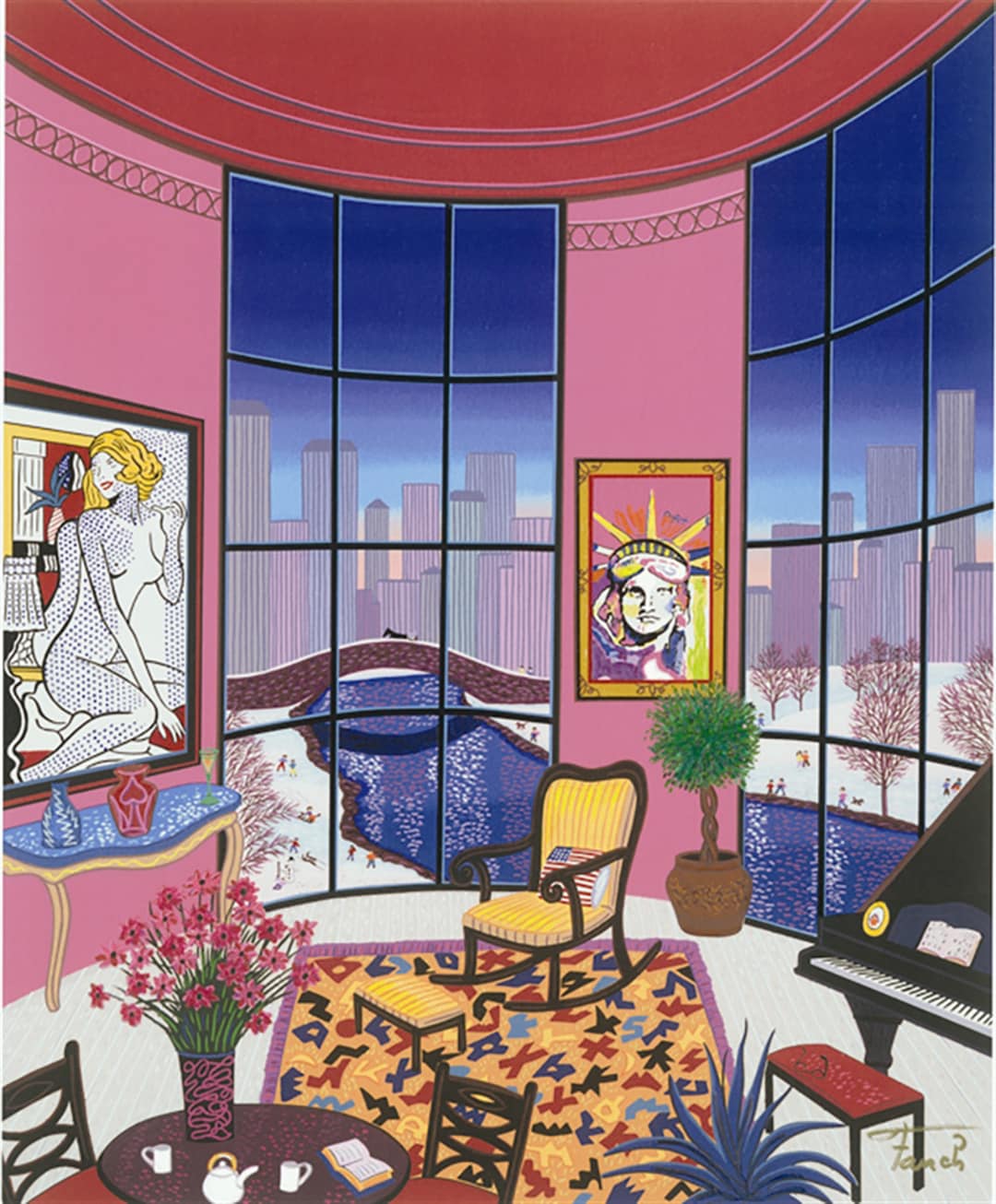
“Interior with Litchenstein” (2006), Fanch Ledan
Fanch was able to replicate the color effects of his paintings in his lithographs by working with highly skilled and sensitive chromists, or color technicians, in the famed print ateliers of Paris—Desjobert, Grapholith, and Artestampe. In these studios, sophisticated color separation, split fountain, and registration techniques produced images that beautifully capture the range and subtle gradations of color, and the meticulous detail found in his paintings.
“Ballooning over Golden Gate Bridge,” 1988, a lithograph based on a painting from 1987, demonstrates the high quality of his published work at the time. The view is across San Francisco Bay to Sausolito, then the location of his home/atelier. Fanch included elements that characterize many of his paintings: a local monument (the Golden Gate Bridge), a leisure-time activity (sailing), and colorful highlights (the hot air balloons and the sailboats’ spinnakers).
An avid sportsman who especially loves water sports, Fanch frequently used these favorite motifs in his views, whether depicting the rivers of Paris, the tropical beaches of Bali, the harbor of Sidney, Australia, or the Mediterranean coast in France and Italy. Fanch’s time spent working at these Parisian ateliers, and others such as that run by Circle Gallery in New York, was important not only for the development of his palette and his style, but these studios also provided a nourishing environment and opportunities to meet other graphic artists.
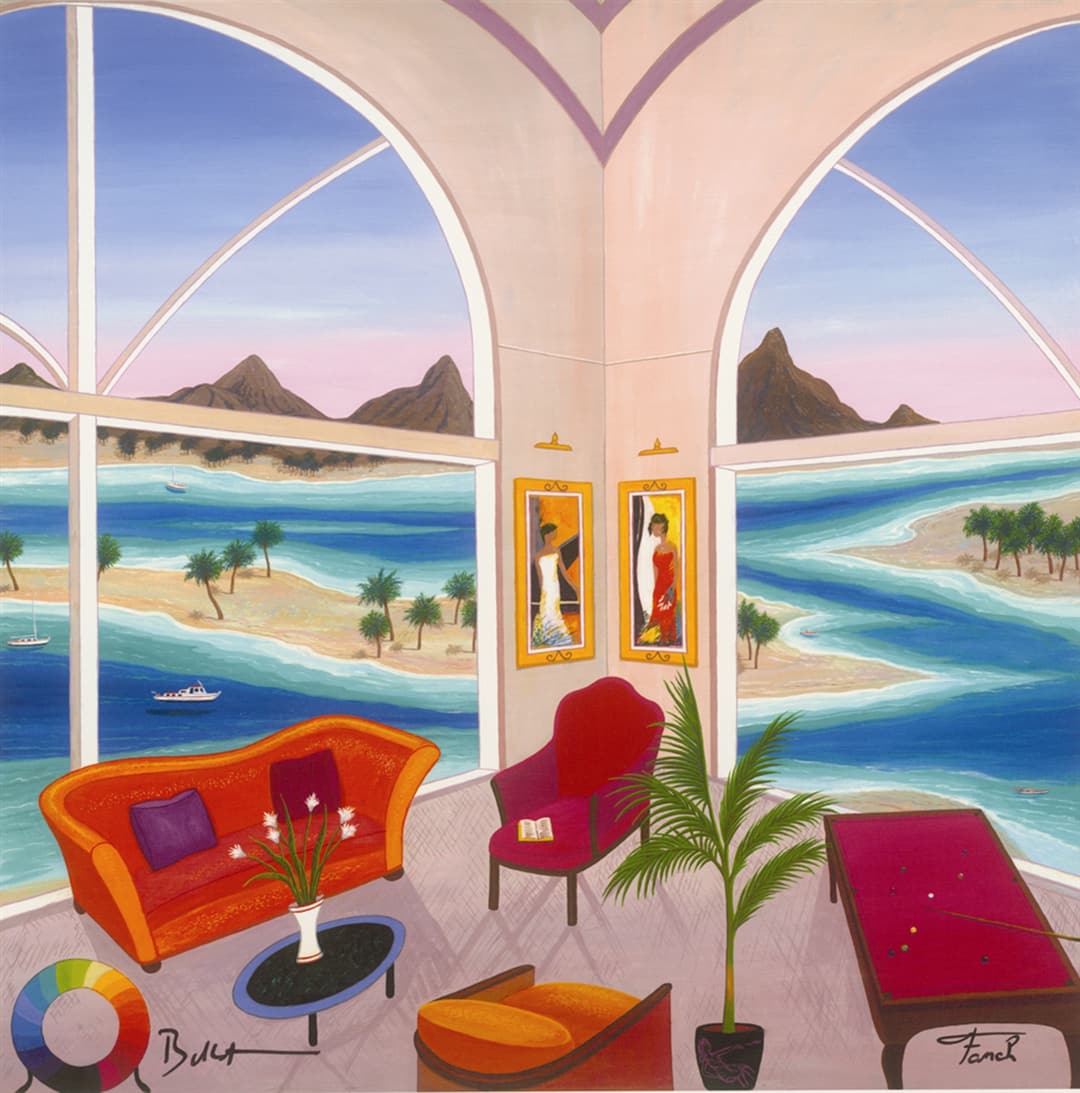
“Interior with Bellet” (2006), Fanch Ledan
In the early 1980s, Fanch also began to work on paintings that he refers to as “interiorscapes” or “interior visions.” One of the first, “The Striped Divan,” 1983 (lithograph, 1983), is a view west across Central Park in New York City to the twin towers of the Eldorado, an art deco apartment building built in 1931. Undulating colorful stripes of the inviting couch and pillows lead to the view, while the indoor plants, always present in his interiors, bring nature in to the viewer.
One of the most beautiful of these early interiors is his “Villa Rochambaud,” 1985 (lithograph, “Above Cannes,” 1989). The composition is a complex organization of diagonal patterns of light and varying shades of a cheerful yet serene blue-green held securely into place by the symmetrically balanced wall and the rectangular panes of glass in the windows and French doors.
In the mid-1980s, Fanch began to include paintings by modern masters in his interiors, as he says “to pay tribute and humble homage,” and, in the early nineties, he began to concentrate on this theme. One of the earliest paintings in this genre, “Interior Mirobolant” (serigraph, 1986), includes a number of elements that will appear repeatedly over the next decade and a half.
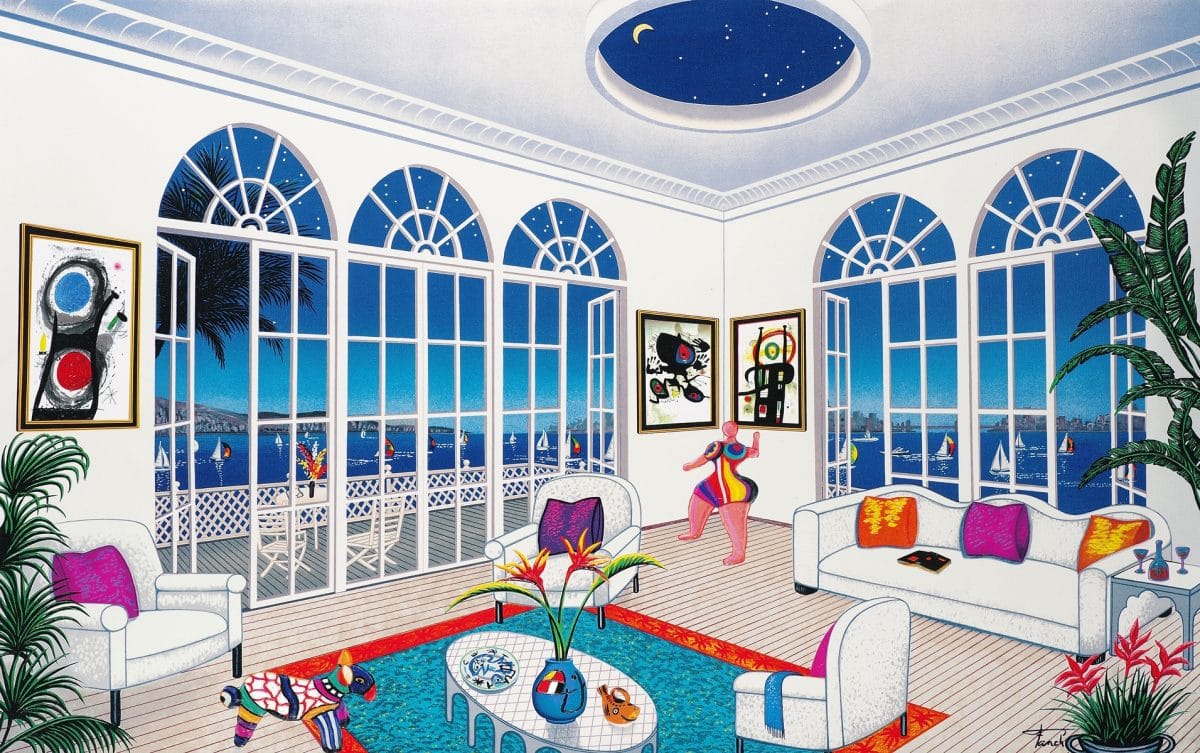
“Interior with Miro II,” Fanch Ledan
In a modern interior, works in the style of Miró, Chagall, and Picasso are displayed with tropical plants and flower arrangements, and a rug inspired by Miró as well. The serene whites of the walls offset the bright colors of the pillows, pictures, and carpet. This kind of interior, however, gave way to his more typical expansive spaces that open to an outside view.
“Interior with Pablo,” 1997 (serigraph, “Interior with Four Picassos,” 1999) is one of a recent series of paintings and serigraphs featuring an open interior with masterpieces and a view of a well-known location. In a way, this image focuses our attention on two sacred spaces: the interior with paintings, sculpture, and music; the exterior with the architectural monuments of Paris.
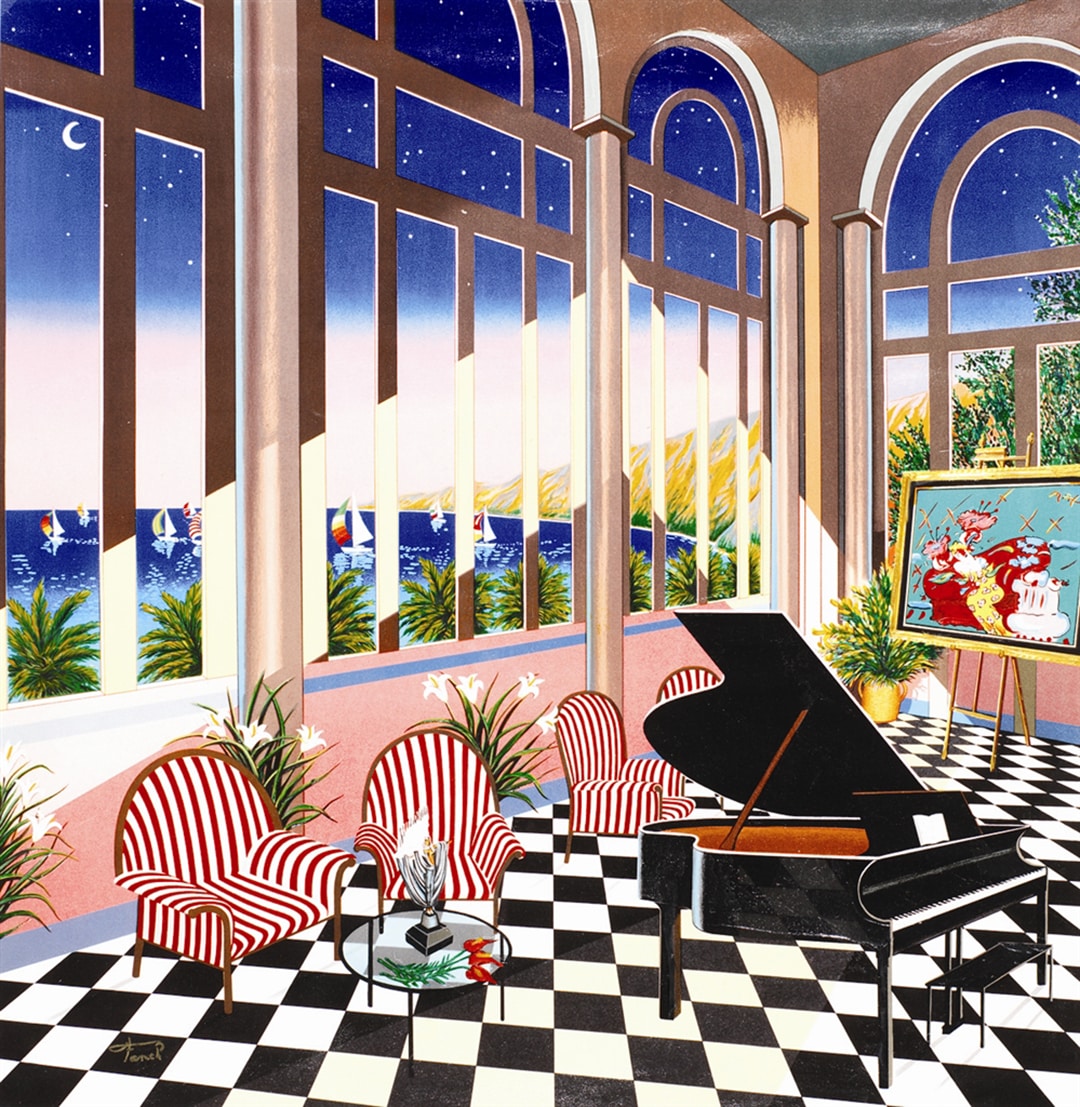
“Interior with Max” (2004), Fanch Ledan
Fanch pays homage to a wide range of other modern and contemporary artists, who in subtle ways have influenced his own art. Additional artists include the Impressionists Monet, Degas, and Cezanne; the Post-impressionists Seurat, Toulouse-Lautrec, van Gogh, and Gauguin; the Surrealists Miró, Dalí, and Magritte; more recent artists such as Lichtenstein and Peter Max; as well as Léger and Mondrian.
As indicated by “Above Cannes” and “Interior with Four Picassos,” if Fanch had not chosen to be an artist or a businessman, he could certainly have become a fine architect. His paintings and original graphics of the 1970s and 1980s constantly focused on the character of specific buildings and urban settings. Once Fanch turned to his interior views in the 1980s, he began to design one interior space after another. While inspired by his collective memories of places he had seen, these interiors spring from his imagination rather than recording specific places.
As might be expected from one who loves the outdoors, these are most often open, airy spaces. There is never a sense of being closed in; there is room to move inside and easy access to the exterior through open windows, or doors to views of a city or the sea.
The style of his architectural spaces is distinctly modern, either with the accents of natural wood favored in Northern California or the white walls and clean lines of the International Style modernist architecture that developed in Europe after the First World War.
More recently, he has moved into the realm of postmodern architecture, bringing back architectural features, such as moldings and pediments that had once been spurned by the modernists. Or he can turn to the Moorish style found throughout the Mediterranean, as in “Patio over Tiny Island,” 2000 (seriolithograph, 2001). Whatever the style, certain features appear repeatedly—high ceilings, doors or windows opening onto balconies and patios—yet, no two spaces are ever the same.
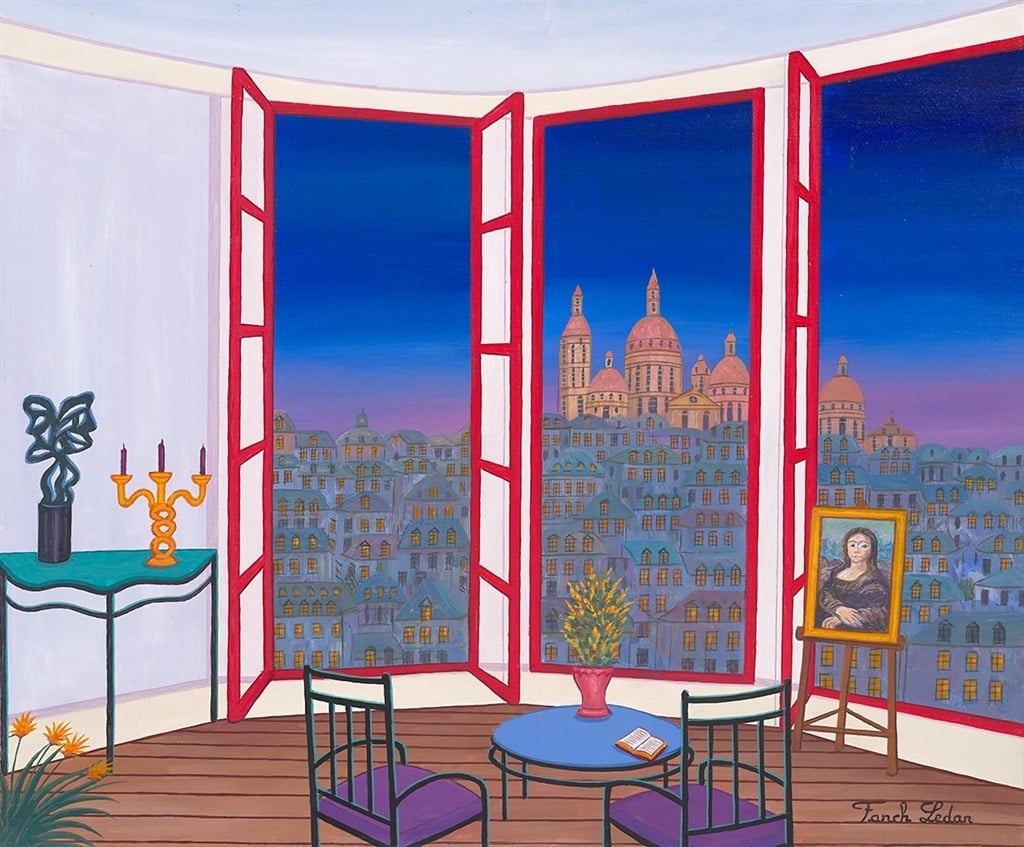
“Red Window on Paris” (2015), Fanch Ledan
Today, Fanch’s graphic art is published and distributed through Park West Gallery in Southfield, Michigan. Fanch first met Albert Scaglione, founder of the gallery, at Artexpo New York in 1983, and soon after Park West began to co-publish and distribute editions of his graphics. Fifteen years later, Fanch and Scaglione entered an exclusive agreement for the publication and distribution of Fanch’s original prints and paintings.
Fanch has experimented with large-scale serigraphy, seriolithography, various papers and linen, and metal reliefs. Working with Ran Bolokan and other chromists and technicians at Romi-Shaked Lavan, Park West’s atelier in Israel, Fanch has been able to obtain a broader range of colors and tones and more intricate detail than ever before, as seen in the cityscape of “Interior with Buddha.” One of Fanch’s serigraphs can require from sixty to ninety screens to achieve the qualities he seeks. Fanch makes additional adjustments to the proofs by working with Park West Gallery in Southfield.
Fanch’s work with Park West Gallery does not mean that he no longer travels. Now, rather than traveling in search of new venues for his art, his trips abroad are related to his own need for creative renewal and artistic inspiration. Nevertheless, it is when he returns home to Vallauris in the South of France that he finds the ideal setting for creating art.
As seen in his serigraph “A View from the Studio,” 1997, for his creative work Fanch has a room with a glorious view onto an expansive and colorful world of tranquility, beauty, and enjoyment. With his wife and sons, constant travel, and successful career, Fanch feels truly blessed, and he in turn passes on fortune’s favor to all those who encounter his art. In the early twenty-first century, when we wonder if humanity is advancing or falling back into the dark ages, Fanch’s optimistic and colorful art lifts us up and gives us joy.
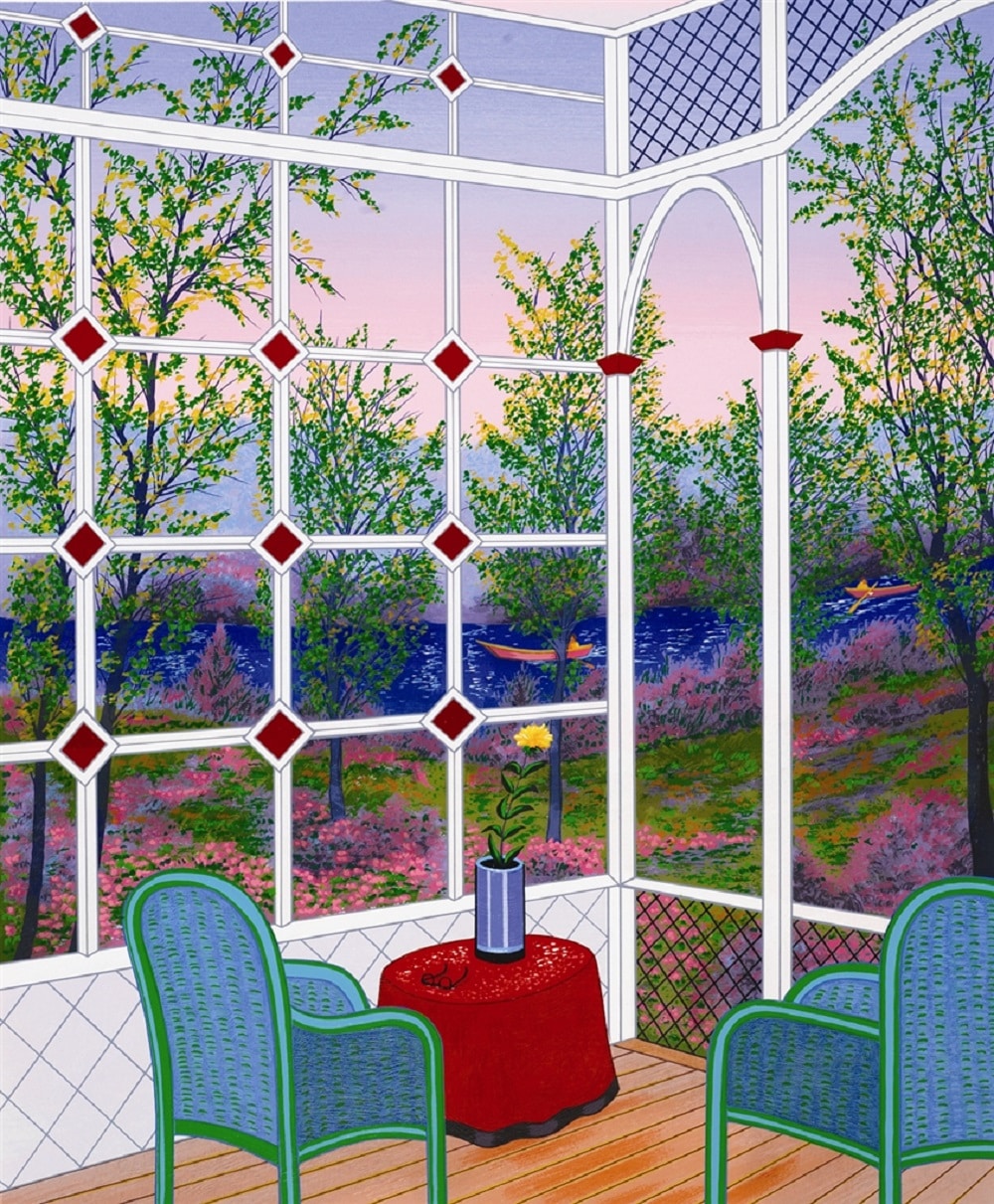
“Patio sur Riviere” (2005), Fanch Ledan
To collect the art of Fanch Ledan, register for our exciting live online auctions or contact our gallery consultants at (800) 521-9654 ext. 4 or sales@parkwestgallery.com.
About the Author: Eleanor M. Hight received her doctorate from Harvard University in 1986 and is currently Assistant Professor of Art History at the University of New Hampshire, Durham. A specialist in twentieth-century art, her publications include the article “German Art 1905-1925: Technique as Expression” in German Expressionist Art: Selections from the Rosi and Ludwigh Fischer Collection (Washington University Press, 1987), and the book “Picturing Modernism: Moholy-Nagy and Photography in Weimar Germany” (MIT, 1995). She has also published essays on Surrealism, contemporary art, and photography, and is the co-editor of “Colonialist Photography: Imag(in)ing Race and Place” (Routledge, 2003).





